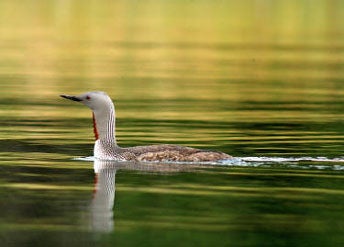SCIENTIFIC NAME:
Gavia stellata
OTHER NAMES:
Red-throated diver
STATUS:
Rare in fall, winter, and spring in all regions except Inland Coastal Plain, where occasional.
DESCRIPTION:
The smallest of the loons with a 39-57 inch wingspan. Both sexes have similar appearances. They have dark gray bodies and a red throat in the summer and pale grey and white in the winter. Several characteristics differentiate red throated loons from other members of the loon family. Its call is a simple wail and rolling growl. Unlike other loons stellata does not have to patter across water surface but may lift directly off water or land for flight. They frequently forage far from their breeding territory and do not carry their young on their backs like other loons. Another attribute different from other loons is both male and female call.
DISTRIBUTION:
A summer range extends along coastal and tundra Alaska and Northern Canada. It also breeds along northern Russia and Europe. Winters along U.S. Pacific coast from Aleutian Islands down to Baja California. Also, along the Eastern U.S. coast from southern Newfoundland to Georgia. Also winters in small numbers on the Great Lakes.
HABITAT:
Breeds in low tundra bogs, wetlands and forested ponds. Migration flocks stage on large lakes. Winters usually in sheltered marine habitat.
FEEDING HABITS:
Like all other divers, loon, they feast on marine life and small fish. Diving and spearing with dagger shaped bill.
LIFE HISTORY AND ECOLOGY:
Displaying for territory, a pair will extend their head and necks vertically, known as the “penguin posture”, then bow their heads and necks downward while treading water. There are two nest types with one being of shallow water grasses and mosses, another being of shoreline built with aquatic vegetation. Typically two eggs are laid with an elongated shape they are brown or olive color with blotches or speckled. The young are capable of swimming within 12-24 hours.
REFERENCES:
http://www.birds.cornell.edu/AllAboutBirds/BirdGuide/Red-throated_Loon_dtl.html
AUTHOR:
Stuart Goldsby, Regional Hunter Education Coordinator, Division of Wildlife and Freshwater Fisheries.






